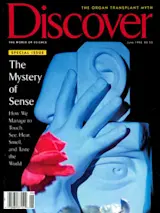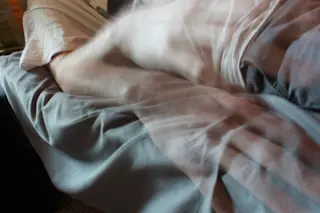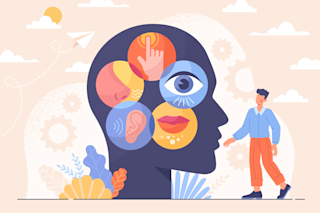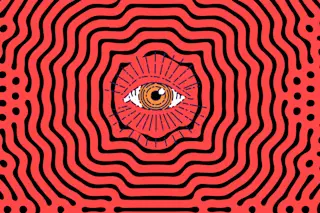The lank-haired teenager in the black T-shirt was stunned. We were both standing in the damp twilight outside San Francisco’s Cow Palace, waiting for the doors to the Megadeth concert to open, and I had asked him a patently insane question.
Wear earplugs during the concert? he echoed, blankly. Why would I do that? Earplugs are, like, condoms for your ears.
His nonchalance about strafing his ears with 115 decibels of heavy metal is sad but understandable: hearing has always been the Cinderella of the senses. Helen Keller thought its absence was more painful and isolating than blindness, yet most people say they’d rather lose hearing than sight. Such second-class status has had a predictable effect on research funding (low), the number of scientists attracted to the field (few), and the rate of progress (slow). As recently as the early 1980s auditory researchers were still laying the foundations for the microscopic and biochemical basis of hearing while their counterparts in vision research were, so to speak, putting up the drywall. As for the numbers, sniffed one biophysicist, Go to the vision meetings and it’s like the Super Bowl or something. He estimates that serious auditory researchers might, worldwide, number 200.
But Cinderella had her moments in the limelight, and it looks as though the Cinderella sense is about to do the same. Technological advances in laboratory techniques, coupled with an aging population--and perhaps a few influential government boomers who put in some hours listening to Stairway to Heaven at top volume--portend a bright future for the field. There is already a whisper of a hint, in fact, that scientists may someday be able to restore some of the hearing receptors my young friend was so casually sacrificing.
Those hearing receptors are called hair cells, specialized sensory cells that are among the most remarkable structures in the body. Only 32,000 strong (compared with, say, the eyes’ 300 million light- sensitive cells), under constant siege from age, drugs, and a world that includes snowmobiles and jet planes as well as Megadeth, they are all that stand between us and silence. Like princesses turning straw into gold, the inner hair cells transform the mechanical forces of sound into the electrical impulses of hearing.
The neurological phenomenon called hearing begins when the ear collects wavelike air-pressure disturbances--sound--produced by any physical force: a vibrating A string, a tree falling in the forest. The outer ear, which includes the fleshy pinna and the auditory canal, picks up and funnels these waves toward the tympanic membrane, or eardrum. The eardrum vibrates and jiggles the three articulated bones of the middle ear; in turn, the last of these three bones, the stapes (or stirrup), flexes the membrane of a small oval window in the fluid-filled, coiled cochlea.
Evolution has been called the great tinkerer, assembling new structures from bits and pieces of old ones, and the ear is certainly one of its most protracted projects. Natural selection has been remodeling and redecorating the ear for hundreds of millions of years, as the latest model of vertebrate moved from the ocean to the shore to dry land. Yet the hair cells at its core have hardly been touched; their structure is virtually identical in the hearing and balance systems of all animals with backbones. As it happens, this is a very good thing, since the cochlea has made mammalian hair cells nearly impossible to study.
The cochlea is one of those structures, like black holes or the Hoover Dam, that tend to provoke awe in observers. It’s a jewel box of an organ, isn’t it? sighed one smitten researcher, interrupting himself in midequation. Said another, It’s such an incredible structure! When I finish a session on the microscope, I feel disoriented, like I’ve been cave diving. The cochlea is indeed amazing: a pea-size, spiral-shaped bony fortress buried in the thickest part of the skull, containing a mechanism of mind-boggling complexity. But like most fortresses, it imprisons as much as it protects. There’s no way to get to the hair cells when an organism is alive, since all the works are barricaded in bone, and the inner ear stops functioning seconds after death. And until recently it was impossible to keep hair cells alive outside the body.
Ironically, though the security system fashioned for the inner ear has discouraged invasions by armies of researchers, it hasn’t worked particularly well at preserving its inhabitants: we begin losing hair cells as soon as we’re born. They simply wear out from use, particularly the cells that process high-frequency sounds. Over time, exposure to loud noise makes them stiffen. No one understands the sequence of cellular events causing the stiffness, but it is known that when hair cells hold this rigid pose too long they just keel over and die.
So it goes: a firecracker too close to the ear here, a jackhammer outside the window there, perhaps even a couple of football seasons in the high-school marching band alongside the tuba and we damage a few or a hundred. By middle age the attrition has become an avalanche: studies have shown that at 65, the average male has lost more than 40 percent of his hair-cell birthright. And, in a phenomenon that might on a bad day strike you as evidence of a malign force in the universe, our hair cells are not able to regrow. Reptiles and amphibians, who have very modest hearing abilities and nonsocial life-styles, replenish their store of hair cells throughout life. We mammals, on the other hand, with our high-fidelity ears, are organisms that depend on hearing to survive both physically and-- in the case of humans and other primates--emotionally. Yet we’re the group stuck with a relatively paltry and nonrenewable allotment.
Within the cochlea, the architecture of the hair cells is supremely functional. The 16,000 cells are arranged in four parallel rows, one inner and three outer rows (relative to their distance from the cochlea’s central pole); they are sandwiched between two membranes, the basilar below and the tectorial above. Together these two membranes form a partition that spirals down the length of the cochlea. When the stapes pushes on the cochlea’s oval window, it sends a wave of pressure through the perilymph, a fluid in the inner ear, which begins a chain of events: the wave sets the basilar membrane vibrating, which vibrates the hair cells, which cause a set of bristles atop the hair cells to brush against the tectorial membrane. There are about 100 of these bristles, or stereocilia, on each human hair cell, and they are arranged in rows according to their height, as if posing for a class photo. When inactive, they lean together in a bundle in the shape of a cone. But when they are active, their movement against the tectorial membrane ultimately results in a signal being sent along the auditory nerve. Thus the hair cells as a whole act as tiny transducers, converting the mechanical impulses they pick up from the cochlear fluid into the electrical energy that the brain interprets as sound.
There’s an undeniably Rube Goldbergian aspect to this chain of events, and elucidating the final mechanical link in the chain (the place where, if the ear were one of Goldberg’s fanciful contraptions for, say, making doughnuts, the dough would hit the fat) has occupied neuroscientist Jim Hudspeth for most of his career. Hudspeth, who is now director of the Center for Basic Neuroscience Research at the University of Texas Southwestern Medical Center, recalls his initial aim: What I saw as important was getting from a macroscopic system--the whole cochlea--to a microscopic and cellular system. That involved ignoring some tantalizing questions; it forced him, he says, to throw away the complicated and interesting mechanics and hydrodynamics of the ear. He also resigned himself to ignoring the complicated and interesting stuff that happens on the way to the brain. I just wanted to deal with one step on an intimate basis. That step was the mechanical input to the hair cells.
The question he and his group of researchers set out to answer was, How do a hair cell’s stereocilia move, and what happens when you move them? In the late 1970s, using a frog as their experimental animal, they found that prodding a stereociliary bundle with an extremely fine quartz fiber--which, given the mere millionths-of-an-inch size of the stereocilia, became known as the telephone pole approach--sent a current through the cells. (This current produces the chemical that excites the nerve going to the brain.) They discovered two surprising things: the direction of this nudge was critical, and the magnitude of the nudge needed to get the stereocilia to respond was infinitesimal.
Hudspeth found that only a push from front or back produced the current; side-to-side nudging did nothing, for reasons that didn’t become clear to the researchers until later. Furthermore, Hudspeth calculated that if the cells were deflected by an amount of prodding equivalent to that produced by a sound at the threshold of hearing, the cilia would move the hair bundle about three-thousandths of a degree. (Just for scale, several atoms in a row add up to a full degree.) In essence, then, the whole jury- rigged mechanism--eardrum to middle-ear bones, middle-ear bones to oval window, oval window to pressure wave in the perilymph, pressure wave in the perilymph to basilar membrane vibration--is distilled to this: a movement measured in fractions of atomic diameters. Observes Hudspeth, It’s as if the Eiffel Tower were to move a thumb’s breadth.
At the time Hudspeth was doing his first work, biologists understood the basic mechanism of cell signaling: a stimulus caused tiny pores--ion channels--to open in the cell membrane, and the movement of charged particles from outside to inside the cell registered as a tiny current change. Vision, for example, had been established as a process in which light hitting the eye’s photoreceptors caused chemical reactions that opened ion channels and excited nerve fibers.
Hudspeth and his group assumed, then, that ion channels must be opening and closing in the hair cells when they prodded the stereocilia. What troubled them was how these relatively sluggish biochemical events could occur in the ear, which is built for speed. You can, after all, trick the eye into believing it has seen movement at 30 images a second, a phenomenon the first animators understood intuitively. But that speed is glacial to the ear: 30 cycles per second (or 30 hertz) is so low in frequency we can barely hear it. A young human ear can, however, process the highest overtone on a violin, a frequency of 20,000 vibrations a second. And our ears can discern the delay when a sound is presented to one ear six to ten millionths of a second after it’s presented to the other. A biochemical cascade takes thousandths of a second--three orders of magnitude slower--and couldn’t possibly do the trick.
To get around the time problem, Hudspeth’s group hypothesized that there might be some kind of mechanical gate to the ion channels in the ear, a device that could open them as briskly--near instantaneously, actually--as the ear’s acuity demanded. Such a device, if it existed, would be unique to the auditory system, but it would at least have the virtue of fitting the ear’s design specs.
There were, Hudspeth makes clear, theoretical reasons and indirect evidence for a mechanical gate. All the same, he says, it was kind of miraculous when the structures began to appear in scanning electron micrographs. They were first recognized for what they were by a British lab, which, recalls Hudspeth, was slightly embarrassing. We’d seen some of them ourselves, but we didn’t know what to make of them. The strandlike structures, dubbed tip links, joined each stereocilium to its tallest neighbor, rather like wires connecting a regiment of telephone poles running over a mountain.
The front-to-back route of the tip links was the reason a side- to-side prodding of the stereocilia did not produce a current. Hudspeth likens the links to pieces of elastic tied to the handle of a door that’s kept shut by one of those noisemaking door-closers at the top of it. That’s the intrinsic elasticity of the transduction channel; it keeps the door closed unless you do something about it. If you pull on the elastic-- that’s deflection of the hair bundle--that tension is communicated to the door. As the hair bundle moves, you’re literally pulling the channels ajar. When the door closes, silence reigns.
The micron-size gadgetry sported by the hair-cell bristles is only part of the unfolding story of how the ear hears. What goes on inside the cell bodies--particularly the bodies of the three outer rows of hair cells--is equally intriguing.
Auditory physiologist Joseph Santos-Sacchi of the Yale University School of Medicine is one of those intrigued. He shares with many of his colleagues an almost paternal affection for the outer hair cells and their antics: This is a fun system to work with, he says. To show how hair cells move and to illustrate just how much fun it is, he made a videotape of a hair cell bopping along to rap star Hammer’s Can’t Touch This.
The outer hair cells that captivate Santos-Sacchi are a mammalian refinement of the more primitive hair cells found in lower animals. Though the outer hair cells are differentiated from the inner hair cells by their position in the cochlea, much more than geography marks their distinction-- the real difference lies in the realm of neuroanatomy.
A nerve is a one-way street: it goes either toward the brain or away from it. Most of the nerves between the inner hair cells and the brain go from the outside in, just as you might expect; after all, our ears are supposed to get information about external events to our brains. Oddly, though, most of the nerves between the outer hair cells and the brain go the other way, from brain to ear. What could the brain be telling the outer hair cells?
In the early 1980s the outer hair cell story got stranger still. Researchers found that the outer hair cells were not only wired oddly, they behaved oddly. Rather than passively vibrating in sync with the basilar membrane, which is more or less what the inner hair cells do, they were bouncing up and down like manic kids on a trampoline. Indeed, they stretched and contracted at a speed that was orders of magnitude greater than any other cell in the body could muster.
This unexpected display of personality by the outer hair cells-- called fast motility--is now one of the hottest areas of auditory research. (Santos-Sacchi has graphed the number of publications since 1985 on a time axis and says that the resulting curve can be described as exponential, going to infinity.) Whatever its research trajectory, fast motility is hot because it poses two intriguing questions: How are the outer cells doing this? And why?
Why may turn out to be the easier question to answer. It’s beginning to look as though one reason the outer hair cells boogie is to accelerate the motion of the basilar membrane.
The 3.2-centimeter-long membrane (about 1.25 inches) spiraling inside the cochlea is essentially an acoustical decoder. It processes the tangled mass of auditory frequencies that make up a sound like speech, sorting them into individual frequency bands. For example, in response to high-frequency sounds, the basilar membrane will vibrate more strongly at the base of the cochlea’s spiral than it will at its apex. Conversely, low- frequency sounds vibrate the membrane more strongly at the apex than at the base. (Like a tiny helical keyboard upended on its highest note, the basilar membrane processes about one-third of an octave per millimeter.)
But--and here’s the mystery--the basilar membrane vibrates at frequencies a hundred times faster than any movement it could conceivably pick up merely by riding the sound wave that travels through the perilymph fluid in the inner ear. Might the outer hair cells be dancing in order to modify the movement of the basilar membrane? Might the connections between brain and outer hair cells be there so the brain can tell the hair cells how fast to dance?
Santos-Sacchi frames the problem thus: Can outer hair cell motility function in the living animal as we all hope it might? That is, can the cells wiggle and modify the mechanics of the inner ear at the high frequencies at which the ear works? There are reasons to think they can; after all, they must be moving for a reason. And drugs that were used experimentally to knock out the hair cells definitely altered the mechanics of the basilar membrane.
That’s the why; the how of fast motility may be a little trickier to answer. In the laboratory, hair cells can’t be coaxed to move any faster than a few thousand cycles a second, not nearly the frequencies that must be attained in living animals. Santos-Sacchi suspects his laboratory apparatus may be preventing the cells from really cutting loose, wigglewise. He thinks the limiting factor is the electrical resistance of the electrode he’s using to deliver stimulus to the cell: It’s as if I were trying to measure how fast a car could actually go, but my broken ankle prevented me from pushing down on the accelerator.
However, another problem is not so easily explained away. At the base of the basilar membrane, where high-frequency sounds are decoded, hair cells don’t seem to have the juice to alter the basilar membrane vibration. What researchers are left with, then, is two remarkable phenomena--the highly tuned basilar membrane and the rapidly moving cells--and no obvious bridge to connect them. There is something missing here, Santos-Sacchi admits. Things don’t quite jibe yet. But he’s sure the connection is there. Think about it, he asks rhetorically. Would evolution go to all this trouble for nothing?
Of course, the average heavy-metal fan could argue that evolution didn’t go to quite enough trouble. The auditory system is elaborate, sensitive, and ingenious, but it does break down before its owners do, particularly if they’re partial to noisy environments. Yet even this flaw may eventually yield to research.
In the mid-1980s researchers made a remarkable discovery about birds that may have important implications for us. Everyone had assumed that our feathered friends, who have relatively acute hearing, were in the same boat as mammals vis-à-vis hair cells: when you abuse ’em you lose ’em. But in 1985 both Doug Cotanche, then at the University of South Carolina, and Ed Rubel, at the University of Washington, found that in young chicks hair cells could regrow.
In Rubel’s case, it was a classic story of scientific serendipity. His lab was using the chicks as their experimental animal to study the ototoxic properties of a class of antibiotics--that is, they wanted to see to what degree the drugs damaged hearing organs. Raul Cruz, the medical resident running the study, found that the number of damaged hair cells was greatest just after we administered the drug, recalls Rubel. But when a little time had passed, there seemed to be more and more healthy cells. He brought me the results and I, like anybody who has completely bought into the dogma of his field, said, ‘Raul, you must have counted the hair cells wrong. Go back and do it again.’
Well, as anyone familiar with Hollywood movies or checkout-stand science fiction could have told Rubel, the counting was fine but the dogma was wrong. There really were more hair cells because new ones were growing. Meanwhile, in South Carolina, Cotanche and his colleagues were seeing what looked like embryonic hair cells on the noise-damaged cochleas of adult birds, leading them also to suspect that the hearing organ might be repairing itself. A collective Aha! ensued, followed by experiments designed to isolate hair cell regeneration. These have confirmed that hair cells in birds do grow back.
And the new hair cells work. The researchers have trained starlings to peck at a key in response to a given tone by rewarding the maneuver with a food pellet. Immediately after they’re dosed with ototoxic drugs, trained birds will fail the tone test, but they gradually regain the skill as hair cells regrow.
Furthermore, the birds’ ears sound as if they’re up and running. Although no one yet understands why, it turns out that a click or other soft tone made in a functioning ear will echo microseconds later. If the hair cells are damaged, the echo is absent. These otoacoustic emissions are the best tool yet for diagnosing deafness in infants, which is what Susan Norton, a researcher-clinician who works with Rubel, usually does. Recently, however, she has been using the emissions to track the recovery of hearing in Rubel’s avian subjects. Norton finds no emission right after the hair cells are damaged; with time, as the hair cells regenerate, the emissions return, first to high-intensity sounds and then to low.
The big question, of course, is what this work means for human hearing. Very little work has been done on mammals, Rubel cautions. His group has looked at the cochleas of gerbils and seen a small increase in cell growth, although they saw no new hair cells developing. Other labs have found small rates of hair-cell regeneration, but only in the segment of the inner ear that controls equilibrium. In March, Andrew Forge of University College in London and Jeffrey Corwin and his colleagues at the University of Virginia School of Medicine announced that they had observed hair-cell regeneration in guinea pigs. The Virginia researchers also found, in culture, signs of human hair-cell regeneration by using human tissue taken from the area of the cochlea (called the utricle) responsible for balance. Even though these are balance hair cells, the researchers are excited about the implications this raises for regenerating hearing hair cells.
But first things first: the current task is to isolate the molecule that stimulates hair-cell proliferation in birds. (Or, if a molecule inhibits proliferation in mammals, to find that.) Several labs are now working on the problem, aided by biotech companies eager to be part of research that might, over the long haul, produce a drug useful to some of the 28 million Americans with hearing loss.
Rubel is expansive about the possibilities: We’re at an absolutely wonderful time in the history of biology to have discovered this, he says happily. We are learning so much, and we have so many powerful techniques we couldn’t imagine when we were in grad school. It’s early yet, he takes pains to point out. You’ve got to remember, this whole field of hair-cell regeneration is only four years old. But we’re doing great! And in my opinion, he adds, when you talk about actually restoring hearing, hair-cell regeneration is the only game in town.














